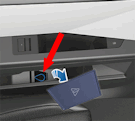Park outside Earlier this month, Chrysler issued a recall for 320,065 Jeep plug-in hybrid vehicles because of a risk of fire while driven or parked. This resulted in a park outside and away from structures and other vehicles recommendation. This comes on the heels of a similar recommendation to some 200,000 BMW owners as well …
Tag: NHTSA
Permanent link to this article: https://dashboardsymbols.com/2025/11/more-fire-risk-seen-in-new-jeep-recall/
Permanent link to this article: https://dashboardsymbols.com/2025/11/jeep-follows-bmw-with-a-park-outside-recall/
Rear-view camera display failures continue to dominate recalls
Rear-view camera Other recall issues tend to get the attention, but rear-view camera display failures continue to dominate National Highway Traffic Safety Administration (NHTSA) recalls. Not our first post one this topic… Getting the attention are such things as on Nov. 4, when FCA recalled 2020 to 2025 Chrysler Jeep Wrangler 4Xe and 2022 to …
Permanent link to this article: https://dashboardsymbols.com/2025/11/rear-view-camera-display-failures-continue-to-dominate-recalls/
Cybercab — who covers liability?
Liability We posted a few days ago about Tesla CEO Elon Musk’s claims that the company would begin production of the self driving Cybercab in the second quarter of 2026. And we completely forgot about this — who cover’s liability? If there is no driver and the expectations are that the vehicle will go station …
Permanent link to this article: https://dashboardsymbols.com/2025/10/cybercab-who-covers-liability/
Lawsuit claims two are dead due to flawed electronic door designs
Flawed electronic door The electronic lock and latch beat goes on. The parents of Krysta Tsukahara and Jack Nelson have filed lawsuits against Tesla claiming that flawed electronic door designs are responsible for the deaths of the two college students in a burning Cybertruck. The suits, filed in Alameda County Superior Court, Alameda, CA, are …
Permanent link to this article: https://dashboardsymbols.com/2025/10/lawsuit-claims-two-are-dead-due-to-flawed-electronic-door-designs/
@NHTSA looking into Tesla door handles — now look into ALL electronic latches!!!
Electronic latches Just a week or so after finding that China is rumored to be considering a ban on electronic latches (door handles), particularly those that conceal themselves (flush handles), comes news from Reuters that the National Highway Traffic Safety Association (NHTSA) is investigating possible door handle issues in over 170,000 Tesla Model Ys. And …
Permanent link to this article: https://dashboardsymbols.com/2025/09/nhtsa-looking-into-tesla-door-handles-now-look-into-all-electronic-latches/
Chrysler recalls electric models for rollaway risk
Rollaway risk We spotted and reposted a NHTSA recall on the 8th that simply said 2024-2025 Chrysler Dodge Charger and Jeep Wagoneer S electric vehicles. Recalled for vehicle rollaway risk. We had to dig a bit deeper. Jeep Wagoneer models have had previous rollaway issues. This link will take you to a fuller description of …
Permanent link to this article: https://dashboardsymbols.com/2025/09/chrysler-recalls-electric-models-for-rollaway-risk/


More fire risk seen in new Jeep recall
Jeep recall On the heels of a recall item we posted yesterday noting a fire risk in Jeep hybrid vehicles and their high-voltage batteries comes yet another Jeep recall of hybrids with a fire risk, this time due to an issue with its gasoline engine. Unlike the earlier recall, a park outside recommendation is not …
Continue reading